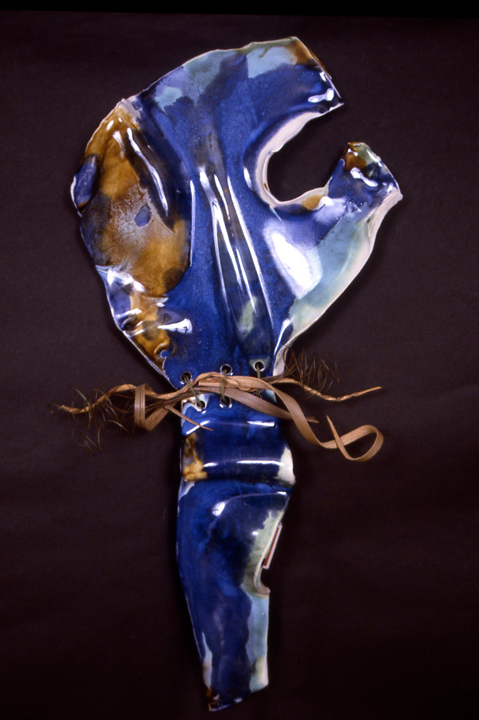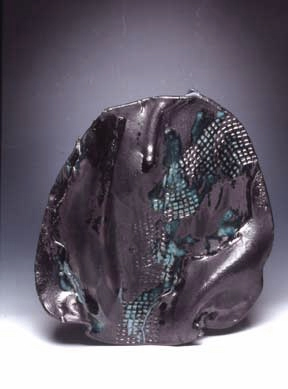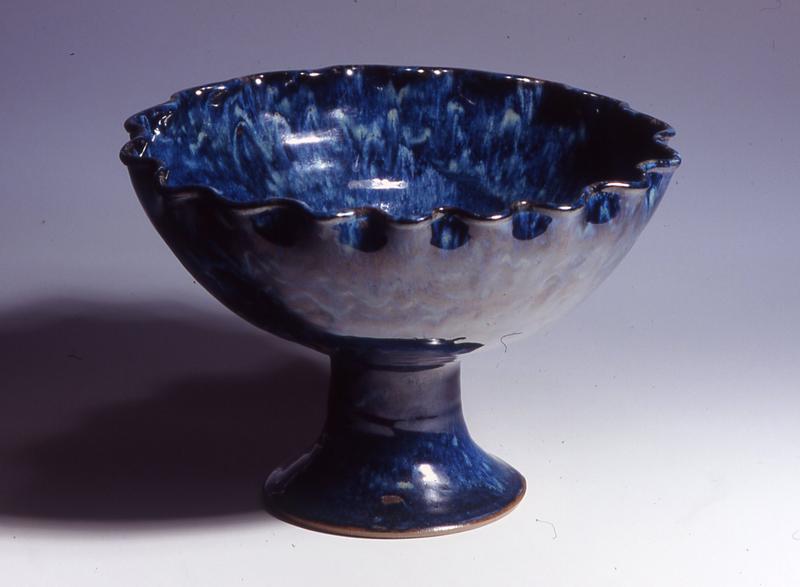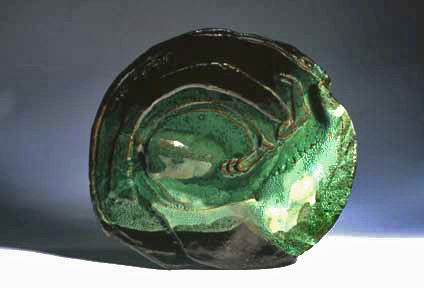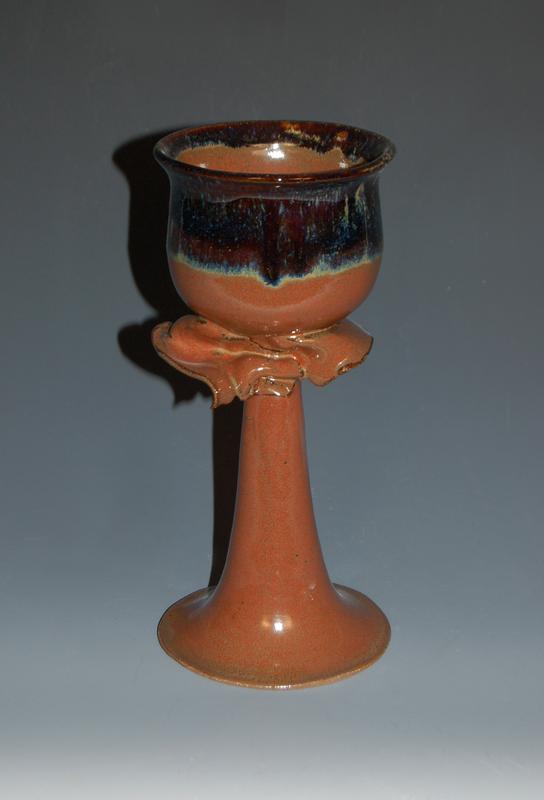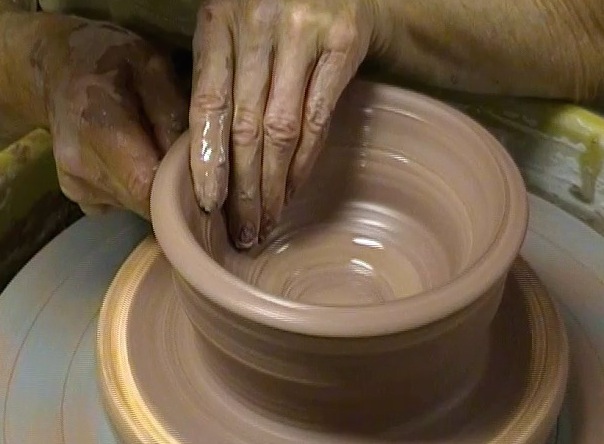THE OXIDATION REVERBERATION
HOW THE GAS CRISIS OF THE 1970’S INFLUENCED AMERICAN CERAMICS
“BARCELONA”, porcelain, 4 ft. x 2 1/2 ft., Clear, Blue Matt, Costello Carbonate and Rutile Matt glazes, 2003
The energy crisis filtered down into Middle America in almost every thing we did. Household thermostats plummeted, roadway speed limits were lowered, and small economy cars were produced by the automobile industry. People were looking toward alternative sources of energy. When we couldn't get oil, we moved to natural gas, coal, wood and electricity, elevating the prices for all these other resources. The cost of propane for firing our kiln skyrocketed. Gasoline prices made travel problematic and we became very selective of the shows in which we participated. Our daily comfort level was altered. We made crucial decisions about heating a large studio during non-working hours. This encroached upon our lives greatly. We had liquid clays and glazes that would freeze during the harsh winters. Therefore, we had to move these perishables into our house at night and bring them back into the studio the next day. Fortunately we were young and strong. We continued working in our craft and sought additional means of financial support. We opened our studio to the public and held classes. Kilnhaus Pottery remained successful, and people loved taking classes in our studio. The increased exposure to the community elevated our pottery sales and we were able to maintain our business. I continued working at Kilnhaus until 1976, when I left to open my own studio.
I moved into the city and was forced to "go electric". At that time my contemporaries looked down upon electric kilns and oxidation glazes. After all, we were hurly, burly, brick and burner reduction fired gas-guzzlers! But all that was changing. I had to make my way in a strange new world. Having built three large outdoor brick kilns, I felt I was committing a despicable act by purchasing an electric kiln. It was stainless steel, shiny and snuggly fit into a corner of my basement studio. I had no clay bodies, glazes or low temperature experience. I bought this kiln because it had the potential of firing up to cone 10, but I soon realized the extent of my predicament. Why bother firing up to cone 10 when cone 6 would be more cost effective? After all, it wasn't the temperature range that was so cataclysmic; it was the fact that I was switching over from reduction to oxidation. That was the whole ball game. Ultimately I made a decision. I committed to work in cone 6-oxidation stoneware and porcelain and recreate the glazes I was accustomed to using in cone 10 reduction. Little did I realize what was in store for me.
I began my journey with stoneware. I surveyed this problem in its most rudimentary components. Simply speaking, a reduction clay body develops its toasty warm color around cone 8 when the oxygen entering the kiln is "reduced" by closing down the kiln's dampers. The glazes are then affected by a second reduction around cone 10, culminating in a brief “cleansing” return to oxidation. This reduction of oxygen and increase in carbon creates the autumnal colors of reduction stoneware.
As my quest clarified, I proceeded to produce a cone 6 clay body that was rich in iron and would develop into a toasty warm color in oxidation. I read everything I could on clay bodies, clay chemistry and Chinese and Japanese pottery. Whenever I delved into new areas of research, Asian ceramics always provided me with a wealth of information. I finally developed a clay body that was suitable to my needs. Then I began identifying my cone 10 reduction glazes and first determined how to bring down their melting temperatures to cone 6. Working with the characteristics of the glaze components, I amended the vitrification, viscosity and surface texture to simulate my cone 10 glazes. I delved further into chemistry, learning the various effects oxides produced in an oxidizing atmosphere. Very slowly, and with many glaze testings, I began to obtain the colors I was seeking.
My first success was to duplicate a cone 10 reduction iron saturate glaze from my college days, "Ketchup Red". I was able to duplicate the glaze in complexity of color and richness of surface. The new "Ketchup Red" was successful and reliable, kiln after kiln. I then continued down my palette of colors, creating blacks, blues, and stony beiges, each one with their own characteristic textures of gloss, stony matte and creamy matte. This process took two years. I continued selling pottery throughout this; I had to make a living. For a long time I was working with only one glaze, but fortunately people were buying my pots. I then ventured into porcelain. By this time I was quite knowledgeable about cone 6 oxidation chemicals and atmospheric conditions. However, trying to learn about mid range porcelain was like beating my head against a stonewall. No one knew anything about it. There was very little information circling the network. There were no computers then, therefore, no World Wide Web. My network was letters, phone calls, articles and personal connections. I wrote and spoke with people all over the country. I felt as if I were in the 9th century, trying to seize the precious secret of the Chinese porcelains! Eventually, more and more people began exploring mid range white clay bodies.
Painstakingly, I developed a white porcelain clay body with which I was satisfied. It was not translucent, but translucency was not a quality I was pursuing. Because of this characteristic, and the mid range temperature, there is some debate over whether or not it is truly porcelain. For me, it is a clay body that is beautifully white, dense, non-brittle and throws fantastically. The body contains bentonite, enabling it to be plastic, very strong and can even be once fired. I found out years after I developed the body that my clay distributor believed it to be one of the best slip casting bodies he has ever used. It is now used by several tile and slip casting companies for industry. Because of the bentonite content, which acts as both a plasticizer and a deflocculant, it is more difficult to mix than other clay bodies, therefore making it more expensive. However, I love it. I can be very casual with it, due to its plasticity and strength and it is fabulous for large sculptural pieces. With the addition of sand, my clay distributor sells it as a white Raku body.
My next endeavor was to develop glazes for my porcelain that would duplicate traditional Chinese and Japanese porcelain glazes. I love those celedons! I was seeking a pure clear glaze and a subtle celadon. After much work, I produced a wonderful clear glaze. It is very clean on the surface, and as it pools into crevices, it transforms into a lovely robin's egg blue. It reminds me of the beautiful Scarab Vase by Adelaide Robinueau. If you look closely at her pot, the pooled areas are a lovely soft blue. This realization hit me like a thunderbolt! What I should have done so many years ago is research the glazes of our own American art potteries. Ironically, many of them worked in oxidation. The answers were there; I just didn’t know where to look. After developing the clear base, I altered the glaze with the addition of Zircopax, creating an opaque shiny white that is great for the insides of casseroles. I then took that base glaze and experimented with different percentages of copper carbonate and iron oxide, developing several beautiful celedons. Now I had good stoneware and porcelain clay bodies and several reliable glazes. I discovered that by multi glazing, I could achieve certain cone 10 reduction effects. I began layering my glazes and building an extensive palette. I loved the delicacy of the Japanese Hare's Fur glaze. By layering Gloss Black over Ketchup Red, I achieved a rich Hare's Fur. When I layered Gloss Black over Matt Blue, I achieved a mystically speckled Midnight Blue. I learned to work with base glazes, varying the oxides to afford additional glazes.
The years progressed, and it seemed the entire country was firing electric. Kilns got better, clay and glaze recipes filled books and publications and the Internet was born. I was able to procure new recipes with the flick of a finger. I am still amazed at the expediency of information today. A new expression in American ceramics flourished.
I often think how my father taught me to be flexible while working out problems. As a child I spent all my free time with him, working on projects around the house. He knew little about home renovation, but continually sought out help. Our weekends were spent in hardware stores learning about tools and home repair. He ultimately renovated three houses. From him I learned innovative problem solving and how to ask for help. Developing my cone 6 palette was an enormous struggle, but ultimately I learned a great deal about clay and glazes. I extended that knowledge into a lifetime of teaching and have derived great pleasure in sharing my recipes. During my thirty odd years of clay making, I have met wonderful people who shared with me their time, glazes, studios and hearts.
The energy crisis of the 1970's provided America with a new ceramic vocabulary. Majolica was born out of Europe's quest for Chinese porcelain; America's energy crisis similarly birthed a facet of art that has made an indelible mark on the landscape of contemporary ceramics. This voyage reinforces our responsibility as ceramists to broaden the American ceramic tradition and preserve its voice in the vast continuum of ceramic history.
This article was published September 2005, Ceramics Monthly Magazine
“ZEN PLATE”, stoneware, 22 in. H. x 13 in. W., Black Matt and Blue Matt glazes, 2004
“PEDESTAL BOWL”, stoneware, 12 in. H x 10 in. W., Gloss Black over Blue Matt glazes, 2003
“KETCHUP GOBLET”, stoneware, 12 in. H, Ketchup Red and Hare’s Fur glaze – Ketchup Red under Gloss Black, 2004
Double click here to add text.
“ALLIGATOR PLATE”, stoneware, 12 in. H x 22 in. W., Black Matt, Costello Carbonate and Alligator Green glazes, 2004
A society's identity is distinguished by its art. The political, economic and environmental climate influences the daily fabric of life. Consequently the artistic milieu of a culture is echoed through the shared thoughts and visions of its people, embracing the arts.
I embarked upon my career during a time of tumultuous dissent. It was the early 1970’s and our country was embroiled in Vietnam. Everyone was protesting something. All the rules were changing, and I was striving to grow up. I moved into a commune and began my long love affair with clay. I met my three partners in 1968 at the State University of New York at Albany, and after graduation we formed a pottery cooperative. Together, we found calmness amidst the turbulence of the times. We built an 80 cu ft. gas fired kiln, furnished a studio and enthusiastically launched the Kilnhaus Potters. Our cone 10 reduction fired stoneware and porcelain was sold in two galleries, one at home and one at a shopping mall. We also sold our work wholesale, shipping pottery throughout the country. We were making a living and living off our art!
Then all of a sudden, everything changed.
When we were students, our university had wonderful equipment and state supported funding. We turned the burners on and out it came-GAS! But in October of 1973, the OPEC nations stopped exporting oil to the US and other Western nations. The results were dramatic. Gasoline prices quadrupled. I remember paying 25 cents a gallon one day, and a few months later, paying over a dollar a gallon. This change impacted all Americans. I remember reading that one week during the crisis, up to 20% of the country's gas stations had no fuel. My partners and I had to take turns going to the gas station to fill up the "family" car. We were on an even-odd license plate fueling policy in our town, and sometimes we waited hours on line to get filled. It was astounding! My friends and I were middle class baby boomers from Long Island and Queens. We came from comfortable homes, never experiencing "need". I imagined that this is how it must have been in Europe during WW II when people had ration books for sugar, jam, and butter. But, this was 1973, and the world wars were over. Little did I understand then that the wars had just begun.
